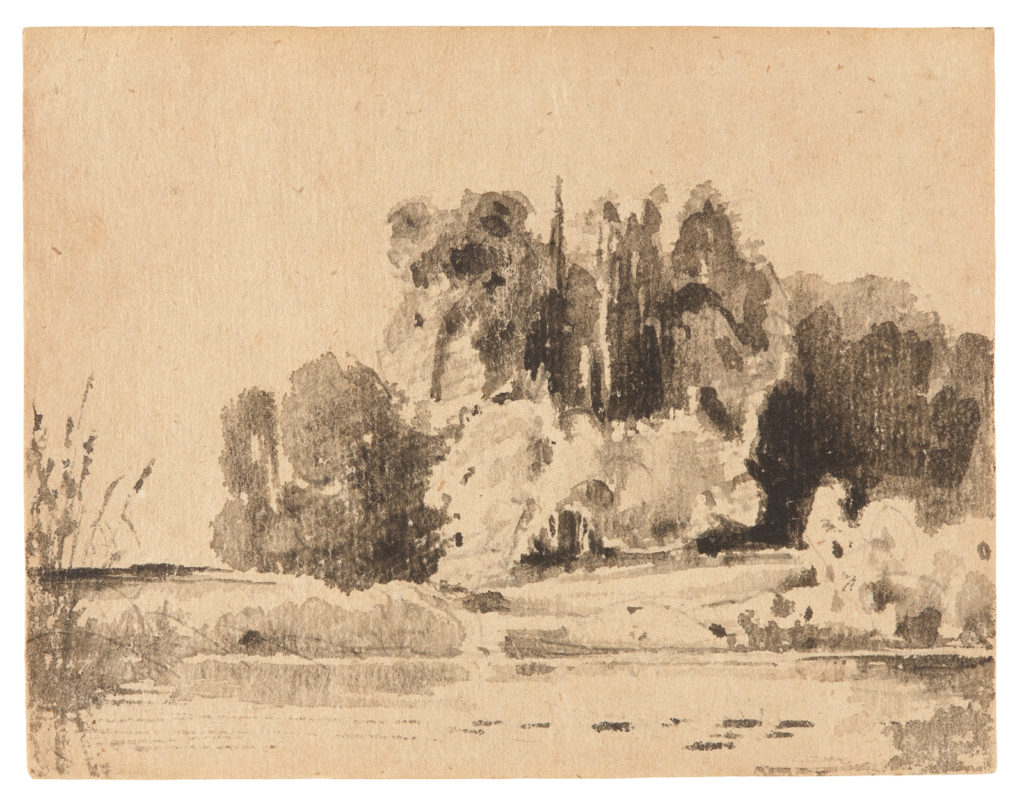Carl Blechen
(Cottbus 1798 - 1840 Berlin)
Pond with Group of Trees, c. 1833-37
Sepia and pencil on paper, 9 x 11.6 cm
Stamp on verso Carl Blechen1 and collector’s mark H.F.W. Brose2
Inscribed in pencil K. 168 I, 103
Provenance:
Estate of Carl Blechen;
H. F. W. Brose collection, Berlin;
Carl Brose collection, Berlin;
Hollstein & Puppel, Berlin, auction XL, C. Brose collection, 8 November 1928, cat. no. 39;
Mrs. Magdalena Schmidt, Berlin (acquired 1928);
Private collection, Germany.
Literature:
Guido Joseph Kern, Karl Blechen, sein Leben und seine Werke, Berlin 1911, p. 168, col. I, 10th drawing;
Paul Ortwin Rave, Karl Blechen. Leben, Würdigungen, Werk, Berlin 1940, no. 1992.
Authenticated by Prof. Börsch-Supan, 19 September 2005.
Carl Blechen’s late work is dominated by woodland motifs, which he treated in many different techniques. Our sepia drawing is a late work that is possibly connected with Blechen’s trip to the Harz Mountains in September 1833. At this time he was teaching at the Berlin art academy and was accompanied by a group of pupils. In 1831 Blechen had successfully applied for the position vacated by his former teacher Peter Ludwig Lütke, who had been Professor of Landscape Drawing. However, from the mid-1830s onward, Blechen showed increasing signs of mental illness, which forced him to give up his teaching post and limit his artistic activities.4
During his travels in the Harz Mountains, Blechen made many oil sketches, some watercolors, wash drawings in sepia, and ink-wash pencil drawings. Professor Börsch-Supan writes: We know from this trip such quickly dashed off works with extensive, fierce strokes of the pen and blotches of the brush, in which bright blank passages are juxtaposed with very dark ones, filling apparently tranquil scenery with explosive power.5 Our expressive sepia drawing Pond with Group of Trees displays the nervousness typical of Blechen, who tends towards the dissolution of the line drawing and well-defined contours and forms.
Our sheet comes from the famous Blechen collection of the Berlin banker H. F. W. Brose. He acquired the main part of his important Blechen collection, including our sheet, from the second part of Blechen’s estate sale, which took place in 1853. In his 1882 description of the Brose collection, Theodor Fontane mentions approximately 70 oil paintings in addition to seven large portfolios containing hundreds of sketches. The majority of the collection was acquired by the Königliche National-Galerie in 1891, whereas the works remaining in the family’s possession were sold by the Berlin auction house of Hollstein & Puppel in 1928.
1 Cf. Frits Lugt, Les marques de collections de dessins & d'estampes, Paris 1956, p. 41: Lugt number L.263b.
2 Cf. Lugt, op. cit., p. 48: Lugt number L.307c.
3 Reference to note in the catalogue raisonné by Guido Joseph Kern, Karl Blechen, sein Leben und seine Werke, Berlin 1911, p. 168, col. I, 10th drawing.
4 On Blechen’s life, see, among others, Peter-Klaus Schuster (ed.), Carl Blechen. Zwischen Romantik und Realismus, exhib. cat. Berlin Nationalgalerie, Munich 1990.
5 Authenticated by Prof. Börsch-Supan, 19 September 2005: Von dieser Reise sind derartig rasch hingeworfene Arbeiten mit ausfahrenden, heftigen Federstrichen und Pinselflecken bekannt, bei denen helle ausgesparte Partien neben tiefdunklen stehen und eine scheinbar ruhige Szenerie mit Explosionskraft erfüllen.

